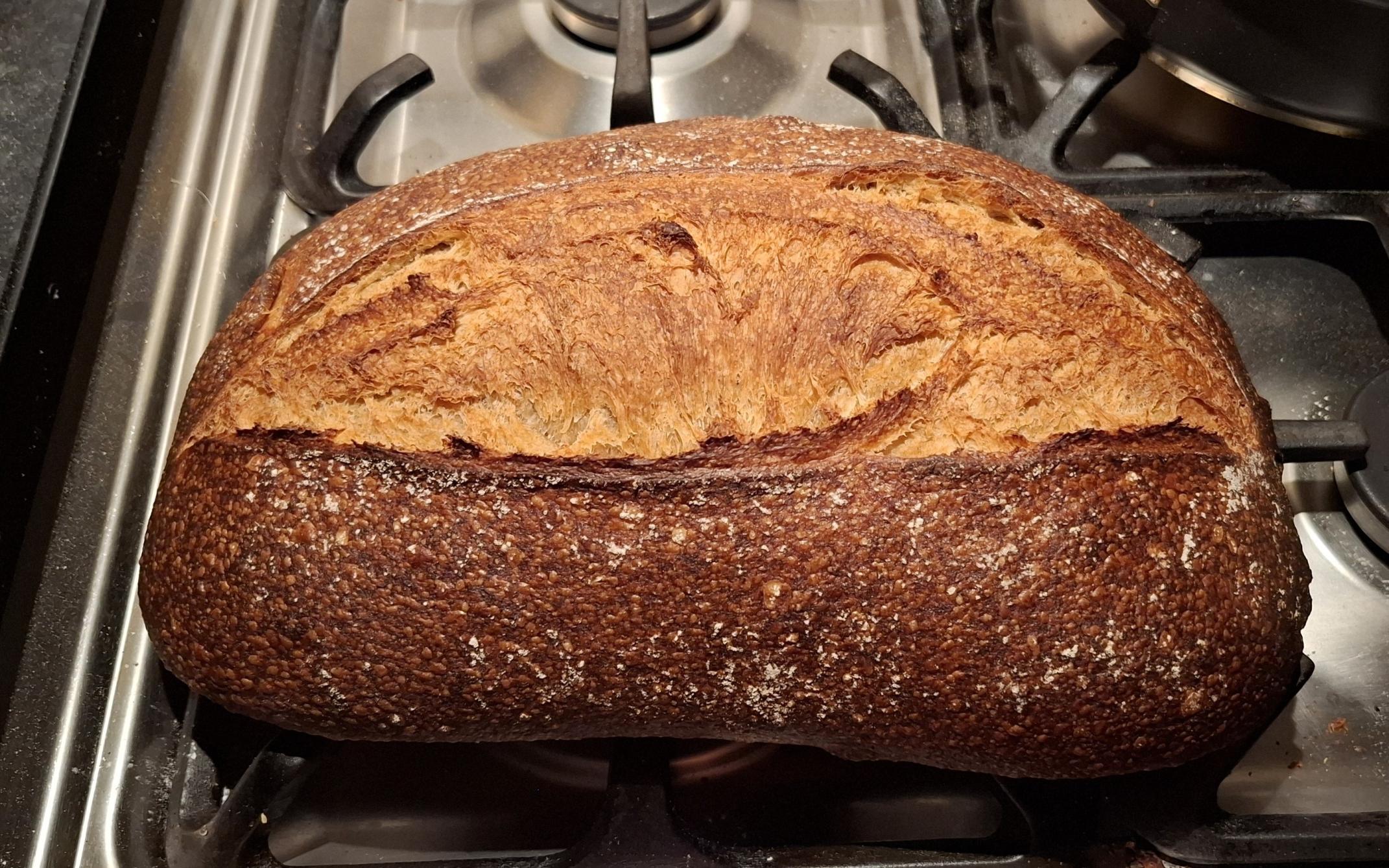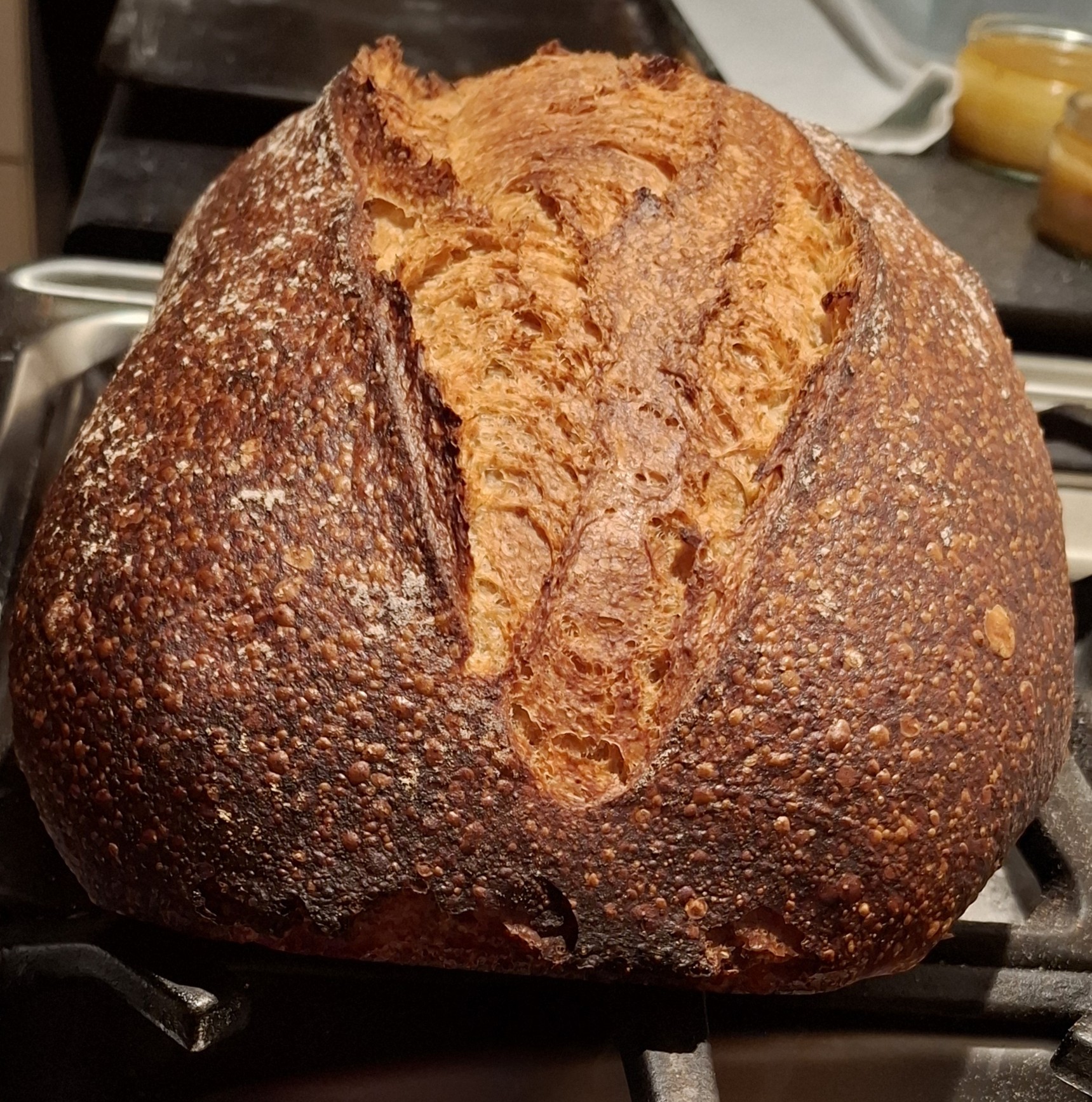Some bread made with high extraction flour and lievito madre.

Notes:
Intensely aromatic with malt scents and that sanfranciscensis sweet cheese aroma. Good oven spring (doubling of height).
LM: 
-


Formula:
| LM Poolish --- 16/18 hours @ 15C | (g) |
| Flour Tipo 00, W380 | 90 |
| Water | 95 |
| LM (50% hydration) | 15 |
| Salt | 0.4 |
| Final Dough | (g) |
| Poolish as above | 200.4 |
| Flour - Tipo 00, W380 | 150 |
| Flour - Stoneground Wholemeal (Sifted to 80% Extraction) | 300 |
| Water | 300 |
| Diastatic malt extract (10-12K pollak units) | 15 |
| Salt | 11 |
| Week old pizza dough | 55 |
| Total | 1031.4 |
| Stats (not including old dough) | |
| PFF | 100 |
| PFF% | 18.2% |
| TF | 550 |
| TW | 400 |
| TW% | 72.7% |

- mwilson's Blog
- Log in or register to post comments
Excellent in every detail!
Paul
You are too kind.
Cheers,
Michael
An interesting grist, with some old dough to boot! It's certainly produced a very nice looking loaf.
I haven't come across Pollak units before, but maybe 12000 is about 150 Lintner? I'm surprised you didn't get a mushy crumb (and you obviously didn't) with a 2.5% addition.
Lance
Despite adding it to all my pizza doughs, I feel like I'm not seeing the effects of diastase no matter how much I add. Thinking about it, maybe it's because my starter is fast acidifying... I might try adding it to an autolyse and see if that makes a difference to the rate of browning. Although with this bake browning wasn't an issue and the maltiness shone through.
Here's the malt I use:
I asked AI if it could approximate Pollak to Lintner, it couldn't. But that makes sense, since the analyses measure different specifics.
Michael
I found a useful artice (from 1934!) which gave some conversion approximations:
That's where I got my figures from.
I actually add malt flour to practically all my doughs, whether sourdough or yeasted, usually at 0.5%
https://www.shipton-mill.com/products/diastatic-malt-flour-500g-307
I like that it helps give a good crust colour and acts as something of a dough improver. Walter Banfield has this to say on the subject:
Lance
Thanks for posting the article. I found it (with surprising difficulty) and was about to post it when I saw your post. I had never seen that unit for malt activity before and it seems that maybe(?) it's only used in Italy in relation to bread/pizza. Unusually obscure unit!
That's such a great-looking loaf! I've been wondering why a LM, since it can produce incredible rises with nearly impossible enriched doughs like pannetone, couldn't produce great rise in more conventional bread. Well, you've answered that!
TomP
LM is capable of great things! Most everything I have been baking for last decade or so has been exclusively leavened with it. Feel free to scroll though my blog.
Here's some picks for lean doughs:
https://www.thefreshloaf.com/node/59520/50-whole-spelt-sd
https://www.thefreshloaf.com/node/65772/100-durum-wheat-loaf-lievitazione-naturale
Sourdough Ciabatta with Emmer | The Fresh Loaf
Michael
Lovely loaf Michael.
A couple of questions as a way to interrogate your expertise.
Wondering about your user of diastatic malt. The prevailing wisdom is that it's not really necessary when using an SD starter as the starter will be rich in enzymes. I can see that you have a really nice browning. Any other reason you included it?
I also assumed that low hydration LM would be used 'as is' in the mixing or used in a similar hydration preferment. Am I wrong or is there a reason you chose to do a poolish in this case.
Sure, I appreciate technical questions.
I can't say I share that wisdom, if we're talking specifically about amylase. Use of SD wouldn't negate the need for amylase addition since breakdown of starch is driven by endogenous grain enzymes. Use of SD might warrant additional amylase since acidification slows it down. Optimum pH for native alpha amylase is pH 5-5.5 and activity sharply declines as the pH reaches 4 and below.
If I reworded "rich in enzymes" to "more proteolytic" then that makes more sense to me.
Beyond the mix of microbes present, a starter accumulates the by-products of fermentation, the building blocks of starches, fibres, proteins and fats are released and these have a knock-on effect in the main dough as fermentation continues on. Once flour is wetted, breakdown is inevitable but as we all know presence of yeast, LAB and acidification speed up the process. Some classic SD loaves (e.g. San Francisco style) show signs of weak browning due to high levels of acidity.
Use of the malt here has really amplified the flavour with intense aromatics and I like a residual sweetness rather than bone-dry. :)
The LM Poolish pre-ferment was the result of a change of plans rather than an intended choice since that's what I do for pizza. The poolish provides low acidity (low TTA) and better extensibility which is ideal for pizza.
Biga - for strength (better gas retention / tighter gluten mesh) - Ideal for enriched doughs and tall loaves.
Poolish - for extensibility (weaker more relaxed gluten mesh) - ideal for low height loaves requiring extension, e.g.; baguettes and flat breads.
Most of what I do is inspired by Giorilli. See: Pane con lievito madre con metodo poolisch in A lezione di lievito madre - Dolcesalato
Michael
Great crust and crumb.
What do you find the LM brings to the table versus using a typical sourdough starter?
Best,
Ian
Much appreciated.
Compared to a more conventional SD starter I would say that LM brings less sourdough, more wheat flavour and leads to a softer crumb. I find some sourdoughs have a crumb that is too firm and I attribute this to higher lactic levels. Elevated acidity (Higher TTA) can actually block fermentation somewhat. However it really depends on how a starter is maintained. LM tends to be less proteolytic inducing and so I can rise the dough to much higher heights. I typically proof to between double and triple and still get lots of oven spring.
The taste of my breads aren't obviously sourdough, they are more bread-like but with the added benefits of sourdough fermentation - more digestible and better flavour.
Cheers,
Michael
Love this loaf Michael. I love reading the ensuing discussions you have as well. Nicely done.
Benny